#ruby from burma
Explore tagged Tumblr posts
Text
Best Gemstone for Sun: Strengthen Your Horoscope
A weak Sun can affect confidence and career growth. Boost its strength with the best gemstone for Sun, like Ruby or Red Spinel. These gems channel solar energy for success and personal power. Buy gemstone online and experience the transformative effects of Vedic astrology for a brighter future.

#best gemstone for sun#ruby stone#ruby stone price#original ruby stone#manik ratna#ruby from burma#manik ratan price#old burma ruby price
0 notes
Text

5 Magical Benefits of Buy Natural Ruby Stone Online
Do you also want to wear a ruby gemstone but are unsure where to buy it from? Searching the buy natural ruby stone online, Brahma Gems is one of the best gemstone shop in Delhi and Noida.
Enhanced Confidence: Ruby empowers you to embrace your inner strength and boosts self-esteem.
Emotional Healing: It helps in alleviating stress and emotional turmoil, promoting a sense of calm and balance.
Passion and Energy: Known for igniting passion, ruby stimulates motivation and enthusiasm in various aspects of life.
Protection: The stone is believed to provide a protective aura, shielding you from negative energies and influences.
Wealth and Prosperity: Ruby is associated with abundance, attracting financial success and prosperity into your life.
#buy natural ruby stone online#ruby stone#ruby stone price#original ruby stone#manik ratna#ruby from burma#manik ratan price#old burma ruby price#burmese ruby stone price#natural original ruby stone
0 notes
Text
jeweler headcanons
now that i've posted my jeweler translations i wanna post my headcanonssss
The stories don't really have a lot of substance to them. Basically they travel through portals called GATEs and it seems like it's for the purpose of traveling to alternate universes where the objective is just to give each Totoko of each universe a pretty gem. They run a shop together in a back alley of Akatsuka ward.
However the Hesokuri canon is kind of nothing and gems and minerals have been a huge interest of mine for months soooo I wanted to expand on that


Osomatsu
He’s got a loupe in his attack art which i think is soooo cute but there’s like a 7/10 chance he would scam you I think. Now there’s a chance he’s just looking through the loupe to make it seem like he knows what he’s doing and he’s bullshitting you but I prefer to think he actually does know his shit and knows what he’s talking about and how to spot a real gem bc ummmm it’s hotter that way.
In my heart I want him to be an honest, trustworthy man. I want to tell you you're safe buying things from him but it's osomatsu......
HOWEVER I think if he does sell fakes, he does have quite a few of them. A lot of glass filled rubies that he sells at the full price of a genuine Burma ruby, imitations and synthetics that are not disclosed as such, and he also doesn’t usually disclose any treatments. Although I don’t think his standards are Quite so low that he’d sell straight glass. But if you give him a good gem to appraise he’ll try to buy it at a lower price and sell it at a hell of a markup. Perhaps the real, high quality gems are only saved for Totoko?
He’s got the charisma to trick a lot of people into buying something that is not worth nearly as much money as he’s asking for, and is probably smart enough to be able to tell when a buyer knows their shit and when he can and can’t get away with bullshitting them. Probably makes conversation first to get a feel of how much you know.
Obviously he still takes on that "leader" role among the brothers. Like they all own the shop but maybe if you ask for the manager, he's the one that'll show up?
Mostly sells faceted gems that are not yet set in jewelry. Doesn't have any rough stones or mineral specimens, and might carry jewelry sometimes, but not much.
Will sell to anyone, but I think his clientele is usually like, the casual jewelry/gem consumer. Doesn't appeal to mineral collectors very much, and will sometimes sell to very very rich people but not often.
It's also shown in the story and his art that he will just shove the gems in his bag carelessly. No wrapping or special packaging, I guess he just throws them in there (which can cause scratches, fractures, and breakages among gems, especially of varying hardnesses)
The gems mentioned in the story are emotites, originally from Pazzmatsu, but I think he also deals mostly in red gems, particularly rubies, but of course he's got stuff like spinels, fancy sapphires, tourmalines, etc


Karamatsu
His attack shows that he only has jewelry, but it's jewelry made of all different types of gems so he may not focus on one particular type like Osomatsu. It also seems to be very big, extravagant statement pieces. In the story he's also shown at what looks like very expensive rich people parties, so while Osomatsu is more geared towards selling to the general public, Karamatsu may specialize in very very rich customers. Also explains why he's dressed so well lol my mans so put together.......
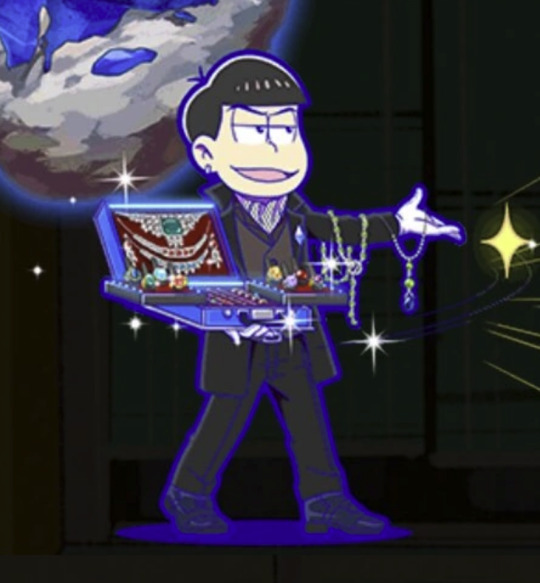
His personal favorite is probably sapphires, or some other blue stone. PERSONALLY. I think his favorites are specifically star sapphires. look at these

I think he’s honest enough that he’s the most reputable of the six to buy from. I think he’s about as skilled as Osomatsu, if not more, when it comes to identifying and appraising gems, but he’s not Perfect so he’s bound to make mistakes and maybe there’s some misidentified things in the mix. But I think he’s like 2/10 most likely to scam you. If you get something you didn’t expect he probably just genuinely didn’t know lmao he somehow doesn’t look as shady as the rest of them so I think he’s probably involved in reputable circles, sells to people that know their shit and doesn’t try to prey on those that don’t know anything.
He also properly packages and cares for his gems, he's not careless like Osomatsu. Also probably something required of him if he's going to be selling to a very wealthy clientele

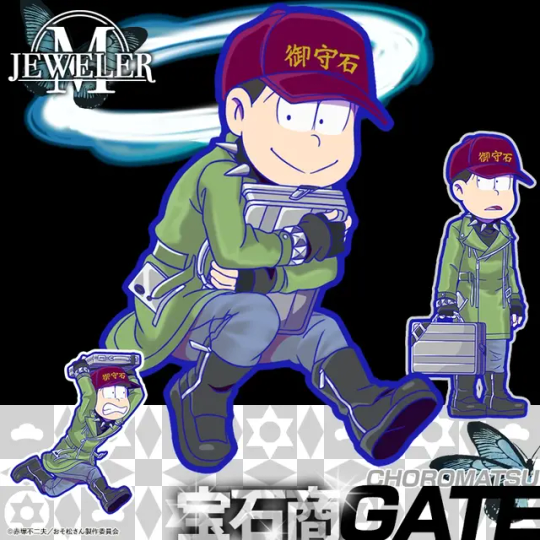
Choromatsu
This guy will fucking scam you he is going to tell you shit that just straight up isn’t true. 9/10 chance you are not getting what you asked for. I went to a gem show in may with my friend and I saw a ‘gem’ that looked like fordite - which is tumbled paint scraped off the bottom of ford car factories. Very pretty but absolutely not a real gem, it's paint. I held it up and asked what it was - expecting the answer to be fordite - and he said some other name that I forgot but upon googling it its basically the same thing as fordite and this mfer said “and that’s naturally occurring!” do you think I am fucking stupid. anyway that’s the shit jeweler choromatsu tells you.
In the story and his art he's shown selling amulets of some sort, and he tries to sell one to Dekapan that's meant to increase libido and claims it's got something to do with cavemen. Despite him only being shown selling amulets, I do think he has small specimens and loose stones. just for me
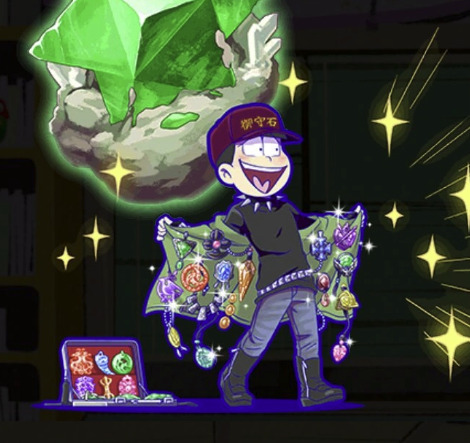
look hes such a FREAKKKKKKK i need him bad
He does Have real gems in his collection, but you can’t trust anything he says about them. He’ll try to pass off any fucking green thing as emerald yes he will sell straight glass. It’s a grab bag of anything. He tells some kind of made up story about the history of it, usually full of some kind of mysticism and what it could bring you. He knows a bit about how to identify a real gem but isn't as skilled as his older brothers.
He also seems at least a little disorganized, what with the amulets hanging on the inside of his jacket and all. It's a system that's organized enough at least that someone unfamiliar could figure it out, but it's also a little bit of like "I know where everything is" kind of a deal


Ichimatsu
His art makes it look like he digs up his gems himself, just cause the gloves and backpack and hat and map makes me think he's out in the field and stuff
The umbrella and blanket sale in his attack art also makes me feel like he’s not As shady as choro but is probably trying to sell them as like “this stone will cure your anxiety” type stuff.

His items are most likely genuine but overpriced. I get the vibe that maybe he digs a portion of his stuff out of the ground himself and is more of a traveling salesman kind of a thing. So part of the stuff he sells is stuff he dug up and cleaned himself and some is stock that he bought from others. But because of this, he's decently good at identifying more common minerals, like the kind you'd find at these spiritual shops. Maybe not that great with rarer minerals, though.
Most of his stuff is likely rough pieces, although I'm sure he has polished points, worry stones, those things carved like hearts.
6/10 likely to scam you just based on the fact that a 2 inch chunk of low quality amethyst is not worth $30 fuck off. he’s essentially the same as any overpriced metaphysical spiritual shop that sells crystals in the shape of penises for $20
I think he does know his shit in terms of scientific information, but he's selling them on the basis of like crystal healing and shit. He also doesn't know that much about crystal healing though he makes up the meanings whenever you ask


Jyushimatsu
the big bag and devious hat and cloak makes me think he stole that shit lmao
He looks like he has a citrine geode in his attack (natural citrine is actually quite rare, a lot of citrine on the market is heat treated amethyst) also it's fucking HUGE so it would be pretty expensive.

I get the vibe that maybe he steals expensive shit like big statement pieces? I don't know. I dont know ......
In the story it seems like he can appreciate both rough and polished stones. He might lean a little more towards rough specimens, but it sounds like he's quite happy with either one
As a salesman I think he's a bit more trustworthy as well? He was trying to sell something to Hatabou in the story but in his own Jyushimatsu way I have trouble truly understanding him.....


Todomatsu
His art and costume makes him look very well traveled, I like to think that he mainly collects rough mineral specimens, usually very rare and expensive collector's minerals. He's got the super niche expensive stuff that the average person doesn't know but that collectors would pay thousands of dollars for. In the story he also mentions picking something up from a mining location, which tells me he's taking shit that's coming straight out of the ground rather than stuff that's already been processed in some way.
Very very knowledgable about his stuff. His clientele is also very niche, like Karamatsu's, because the main people interested in his stuff would be people that are already into mineral collecting.
He's less likely to scam you solely because the people he sells to are usually skilled enough to be able to tell the difference between something real or fake, or an imitation. He has a reputation to uphold, so he can't risk ruining that.
#osomatsu san#ososan#mr osomatsu#hesokuri wars#osomatsu#karamatsu#choromatsu#ichimatsu#jyushimatsu#todomatsu
97 notes
·
View notes
Text
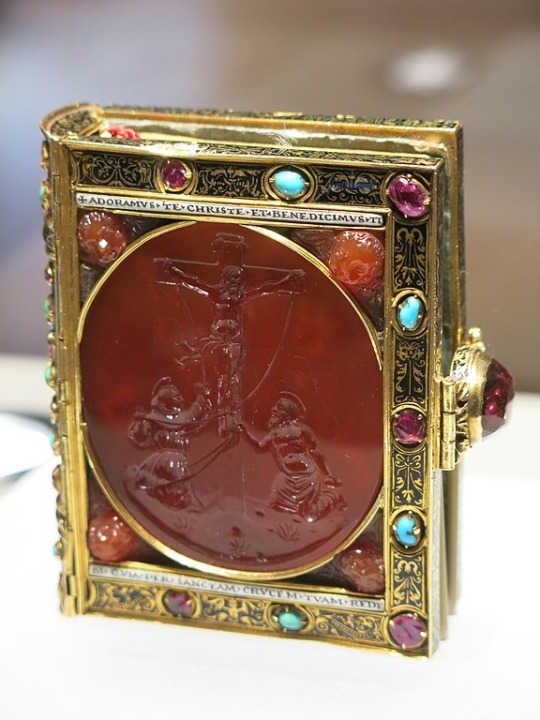
KING FRANÇOIS I BOOK OF HOURS (1578)
A dazzling masterpiece of the French Renaissance.
This small prayer book is bound in enamelled gold and gemstones. It was purchased in 1538 by King Francis I of France as a gift for his niece. The gems consist of carnelian (two intaglios and eight cameos), rubies (27 polished pieces), turquoise (24 cabochons) and rhodolite (one faceted stone in the book’s clasp that has been described as tourmaline since 1942). Most of the rubies were mined from the Mogok area of Burma (now Myanmar). Based on historical considerations, the turquoise could have originated from Persia or possibly Uzbekistan, and the carnelian from either India or Saxony. The faceted rhodolite from India or Sri Lanka, was most likely added to the clasp between 1842 and 1884. [view large]


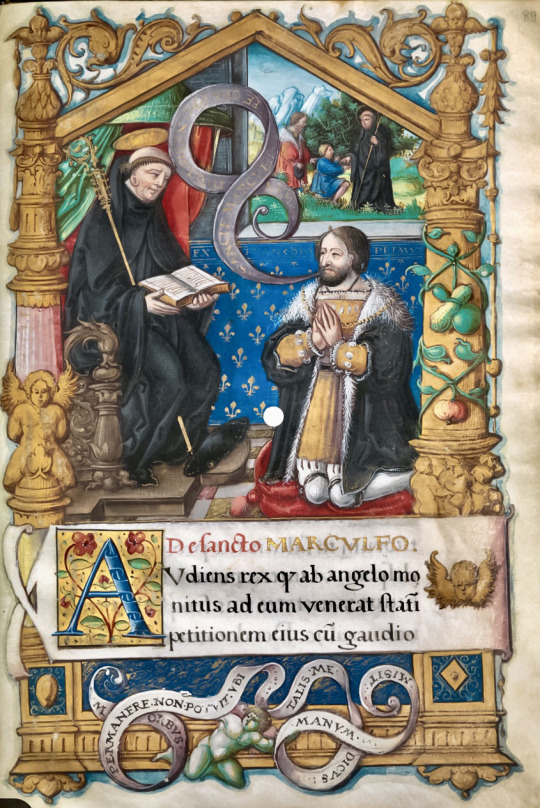

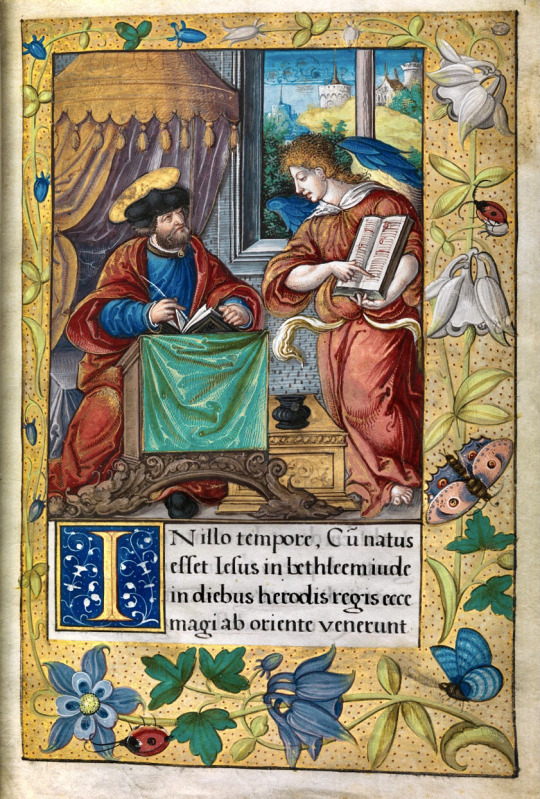
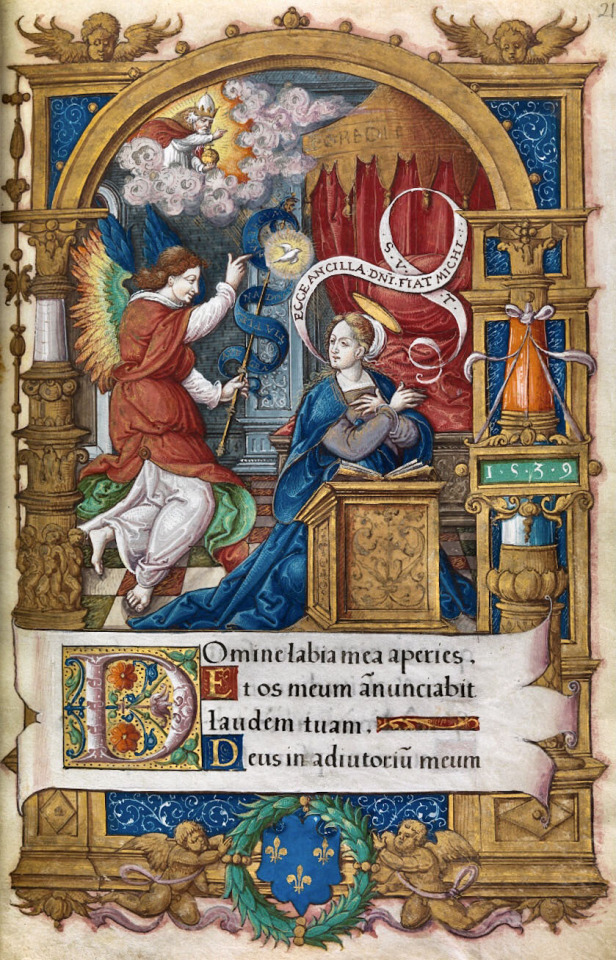


source
#beautiful books#book blog#books books books#book cover#books#vintage books#book of hours#treasure binding#book binding#book design#french#jeweled#illuminated manuscript#illuminated
816 notes
·
View notes
Text
Crystal Healing and Lore of Ruby (A Dive Into The Stone Of Power And Kings)

The history of ruby is extremely complex and goes back thousands of years. The name Ruby comes from the Latin “Rubinus” which means red. It has been said to ward off the effects of poison in medieval times, and when worn or carried by a king it was also said to make that king invincible. Ruby has so many superstitions connected to it, but how does that affect the modern way we look at this precious gemstone? Especially in crystal healing practices, ruby is a potent stone of vitality, and healing. Some say that although it doesn’t truly live up to the old superstitions of warding off death and disaster, it certainly has a protective and empowering energy. Ruby is actually from the same “family” as sapphire, and pink sapphire and ruby are often used interchangeably by sellers depending on their target audience. This “family” that ruby and sapphire are both a part of is called “Corundum”. The most precious variety of red corundum (ruby) is known as pigeons blood ruby and often comes from Burma. Burmese rubies are rare and sought after by many.
SO; How can you use ruby in your healing practice today? First off, you may already own a piece of ruby in your jewelry collection. Small pieces are no less powerful than palm stones or statement pieces, so don’t be intimidated to meditate with ruby stud earrings on, or a small tumbled piece. You can use ruby for a variety of purposes: boosting fiery energy, working with Archangel Michael (who is often associated with this stone as well as lapis lazuli), healing ego and emotional wounds from your past (maybe take a piece of ruby or ruby jewelry to therapy), and meditating on protective and empowering themes in your life.
THINGS TO LOOK OUT FOR WHEN PURCHASING RUBY:
1. HONEYCOMB RUBY. This is becoming a common fake for ruby, and is just chemically identical to ruby while being man grown and structured weirdly. It looks like this:

2. RED SPINEL AS RUBY. Red spinel has fooled the best of us, even professionals in the past and is often marketed as ruby. Even the Crown Jewels are not technically ruby and are instead red spinel. These crystals are formed completely differently, but look similar in color. However, a way to discern whether you have red spinel or ruby is to hold it up to the light. If its got more than one shade of red its more likely to be ruby. If it’s a single shade of red and lacks that pinkish depth it could be red spinel. There is nothing wrong with red spinel, it’s just probably not what you want when shopping for genuine rubies. Another difference is the density. Ruby feels heavier in your hand than red spinel, although this can be hard to tell with small pieces or faceted jewelry.
3. GLASS. This goes without saying, ruby is harder than glass, as it is corundum. If you have something that is less than a 7 on the Mohs scale of hardness and it can scratch your “ruby” then that is no ruby. It may very well be glass.
#ruby#gemology#history#witchblr#witch#nature#witchy#witchcraft#crystal witch#crystal healing#crystals#gemstones
10 notes
·
View notes
Note
can you guys chill lmao. just trying to help
Sapphire is a precious gemstone, a variety of the mineral corundum, consisting of aluminium oxide (α-Al2O3) with trace amounts of elements such as iron, titanium, cobalt, lead, chromium, vanadium, magnesium, boron, and silicon. The name sapphire is derived from the Latin word sapphirus, itself from the Greek word sappheiros (σάπφειρος), which referred to lapis lazuli. It is typically blue, but natural "fancy" sapphires also occur in yellow, purple, orange, and green colors; "parti sapphires" show two or more colors. Red corundum stones also occur, but are called rubies rather than sapphires. Pink-colored corundum may be classified either as ruby or sapphire depending on locale. Commonly, natural sapphires are cut and polished into gemstones and worn in jewelry. They also may be created synthetically in laboratories for industrial or decorative purposes in large crystal boules. Because of the remarkable hardness of sapphires – 9 on the Mohs scale (the third hardest mineral, after diamond at 10 and moissanite at 9.5) – sapphires are also used in some non-ornamental applications, such as infrared optical components, high-durability windows, wristwatch crystals and movement bearings, and very thin electronic wafers, which are used as the insulating substrates of special-purpose solid-state electronics such as integrated circuits and GaN-based blue LEDs. Sapphire is the birthstone for September and the gem of the 45th anniversary. A sapphire jubilee occurs after 65 years.
Sapphire is one of the two gem-varieties of corundum, the other being ruby (defined as corundum in a shade of red). Although blue is the best-known sapphire color, they occur in other colors, including gray and black, and also can be colorless. A pinkish orange variety of sapphire is called padparadscha.
Significant sapphire deposits are found in Australia, Afghanistan, Cambodia, Cameroon, China (Shandong), Colombia, Ethiopia, India Jammu and Kashmir (Padder, Kishtwar), Kenya, Laos, Madagascar, Malawi, Mozambique, Myanmar (Burma), Nigeria, Rwanda, Sri Lanka, Tanzania, Thailand, United States (Montana) and Vietnam. Sapphire and rubies are often found in the same geographical settings, but they generally have different geological formations. For example, both ruby and sapphire are found in Myanmar's Mogok Stone Tract, but the rubies form in marble, while the sapphire forms in granitic pegmatites or corundum syenites.
Every sapphire mine produces a wide range of quality, and origin is not a guarantee of quality. For sapphire, Jammu and Kashmir receives the highest premium, although Burma, Sri Lanka, and Madagascar also produce large quantities of fine quality gems.
The cost of natural sapphires varies depending on their color, clarity, size, cut, and overall quality. Sapphires that are completely untreated are worth far more than those that have been treated. Geographical origin also has a major impact on price. For most gems of one carat or more, an independent report from a respected laboratory such as GIA, Lotus Gemology, or SSEF, is often required by buyers before they will make a purchase.
9 notes
·
View notes
Text
Survived Romanov Jewellery
Caesar's Ruby pendant of Catherine the Great
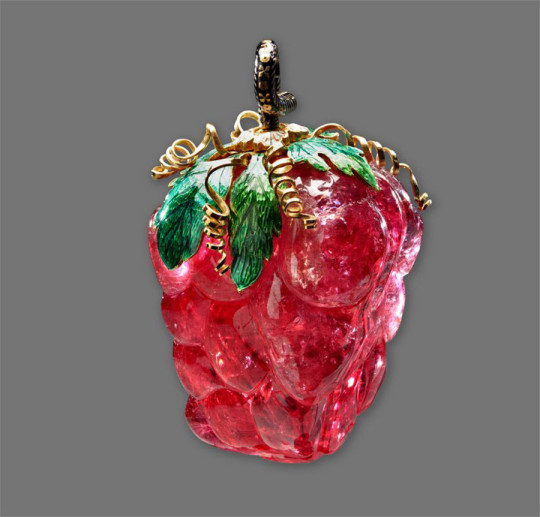
This large crimson stone called rubellite is a rare variety of dark pink tourmaline. In 1777, the stone (in shape of a raspberry) was presented as a gift to Tsarina Catherine II (AKA The Great) of Russia by King Gustav III of Sweden to mark the 15th anniversary of her reign. He told the Russian Empress a legend that the gem had originally been given as a present to Caesar from Cleopatra. It was later established that the stone had actually been brought to Europe from Burma in the 16th century and was considered to be the largest ruby on the continent at the time!
@krasivaa's royal series
#king gustaf#king gustaf iii#swedish royal family#rif#russian imperial family#catherine the great#catherine ii#romanov jewelry#krasivaa#krasivaa's royal series#romanov
48 notes
·
View notes
Text





Royal Tiaras Highlights: Queen Elizabeth II’s Burmese Ruby Tiara
This tiara was made by Garrard in 1973. The diamonds used were originally in the Nizam of Hyderabad Tiara, which was dismantled to create this ruby piece. The rubies used were a wedding gift from the people of Burma, a set of 96 rubies which are all featured in the tiara. The Burmese people believe that rubies protect the wearer from the 96 diseases that can contaminate the human body. The diamonds and rubies are set in rose motifs meant to resemble the Tudor rose.
Via The Court Jelewer
42 notes
·
View notes
Text
The Burmese Ruby Tiara
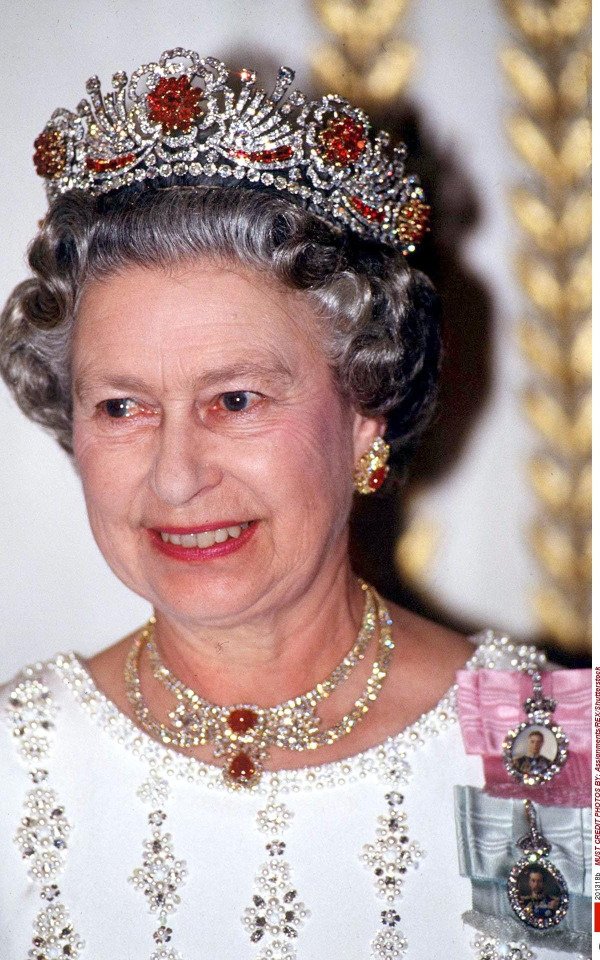
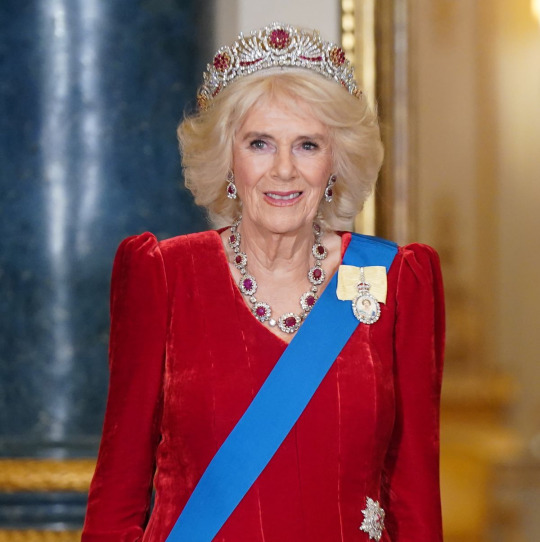
The tiara includes rubies that were gifted from Burma to then-Princess Elizabeth upon her marriage to Prince Philip in 1947. Per the jeweler, "The 96 rubies are a symbolic gesture, as rubies in Burmese culture protect from illness and evil, in this case to protect the wearer from the 96 diseases that can afflict humans. The rubies and diamonds are set in a series of rose motifs inspired by the Tudor Rose, the heraldic symbol of Britain."
11 notes
·
View notes
Text
The Beautiful and Rare: The Burma Ruby
Burma, also known as Myanmar, has been the source of some of the world's finest rubies for centuries. Burmese rubies are famed for their strong and vibrant colour, making them the most desired of all!
Every mine produces a wide range of quality. The fact that a ruby comes from a famous mine doesn’t mean it is good quality... But fine-quality rubies that have Myanmar (Burmese) origin definitely are.

This for example: Edwardian Burma Ruby Cabochon & Diamond Cluster Ring
This beautiful oval shaped Burma ruby cabochon takes centre stage of this amazing cluster ring. The ruby weighs 3.3 carats and looks amazing in both daylight and iridescent light, with a rich and intense colour. The stone is complemented by a cluster of sparkly old cut diamonds, set in a way that creates great movement and placing the ruby to centre stage.


#antique jewelry#butter lane antiques#fine jewelry#antiques#antiquejewelry#edwardian jewelry#burma ruby#ruby jewelry#ruby rings#burmese ruby#burma ruby ring#burma ruby jewelry#mined ruby#ruby engagement ring#edwardian fashion
6 notes
·
View notes
Text
Do you look and buy the Natural Certified Ruby Stone (Manik Stone)?
Invest in the regal splendour of natural certified ruby stone. Our collection features responsibly mined, untreated gemstones with mesmerising red fluorescence.

Rarity: Rubies, especially those of fine quality, are among the rarest gemstones on Earth. They are much rarer than diamonds, which contributes to their high value and desirability.
Vibrant Color: The rich, deep red hue of rubies is unmatched by any other gemstone. This vivid, blood-red color is caused by the presence of chromium in the stone's chemical composition, and it is highly prized.
Historical Significance: Rubies have been treasured throughout history by ancient civilizations and royalty. They were considered symbols of power, passion, and prosperity, and were often worn by kings, queens, and nobility.
#buy natural ruby stone#ruby stone#ruby stone price#ruby from burma#natural original ruby stone#burmese ruby stone price#buy ruby stone
0 notes
Text
ruby
The glowing ruby shall adorn, Those who in July are born; Then they’ll be exempt and free From love’s doubts and anxiety. — Gregorian birthstone poem
In the middle and right at the forefront of the Crown of England is a giant polished red stone. It is called the Black Prince's Ruby - and some people say its cursed.
The stone's story starts in Iberian Peninsula, where legends says that it was owned by Abū Sa'īd, the last Sultan of Granada. Abū Sa'īd was at war with Don Pedro of Castile and finally agreed to surrender. When the two sides met to finalize the agreement however, Pedro lived up to his moniker of 'the Cruel' and murdered the off-guard sultan and his entire entourage. The blood red stone over two inches long was found on the dead ruler's body and Pedro took it as a a trophy. Bad luck came along for the ride. Shortly after the deed, in 1366 Pedro's rule was challenged by one of his brothers and he enlisted the help of the English Edward of Woodstock, a man otherwise known as the Black Prince. After the revolt was put down, Edward demanded Pedro's two daughters - and the stone, in exchange for his help. Within three years, Pedro was dead. Edward, heir to the English throne, didn't live long enough to even rule. After that, the blood stone disappeared until 1415 when Henry V wore it on his helmet in his war with France. He almost lost it, and his head along with it, to an axe blow during the battle of Agincourt. Richard III wasn't so lucky when he wore the same stone during the Battle of Bosworth, where he was killed. Despite that, the stone stayed in royal hands until Oliver Cromwell's rebellion where it disappeared for a time from the records. It showed back up again with Charles II in 1660 though and in 1838 it became the crowning jewel in Queen Victoria's coronation crown.
By then however, it wasn't considered a ruby anymore. In 1783, chemistry had advanced enough to differentiate between rubies and their look-alike, magnesium bearing spinels.
Since July's birthstone is the ruby, let's take a closer look at it before the month is over.
Rubies are considered the second most valuable jewel in the world, one of the Big Four, with the others being diamonds, sapphires and emeralds. They are second in hardness only to diamonds. Ancient sanskrit gave them the name ratnaraj, which means 'the king of jewels'. They have been mined in Myanmar since 2500 BC (or only 600 AD according to another site, though there are records of rubies traveling the North Silk Road from China as far back as 200 BC and they are mentioned in the Old Testament and the Torah so this is one of those wobbly 'facts'). Still, rubies that come from that part of the world are still considered the high standard today. In color, they can range from a red-purple to 'pigeon blood' red to orange or pink. Rubies are used in lasers, with the first one being built in 1960. Rubies from Greenland are said to be the oldest in the world, clocking in at 3 billion years old.
Impressive, isn't it? And anything with this much history, has to have stories that go with it. Let's talk superstition.
With such a rich, red color, of course rubies would be associated with blood. In Burma, India and China, rubies were placed in helmets, breastplates and weapon scabbards, with the belief that they would both protect their wearer and encourage bravery, strength and stamina. In Persia, the ruby granted mental clarity as well as divine power. The Chinese gave rubies to each other as good luck and protective charms. It was said that when evil approached a dark blot would appear on the surface of the red gem and when the darkness cleared away the evil had passed by. In India, wearing a ruby on the heart side of your body will allow you to live in peace. In many cultures, the rich, red color of rubies makes them symbolic of love and passion. Even today, tradition holds that rubies are the ideal gift to give for 15th and 40th wedding anniversaries. Folklore says that rubies help with bleeding, inflammation and body heat.
And, of course, Dorthy's shoes in the 1939 technicolor movie The Wizard of Oz were ruby slippers, which showed up against the yellow brick road much better than the simple silver shoes of the book by the same name would have.
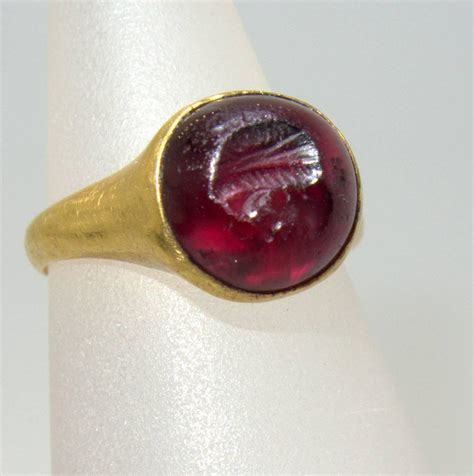
#superstition#folklore#ruby#birthstone#july#history#gemstone#jewelry#good luck#lucky#romance#crown jewels#united kingdom#black prince#edward black prince
14 notes
·
View notes
Text
What are the different origins of ruby gemstone?
Ruby, the fiery king of gemstones, boasts a rich history and diverse origins. Here's an exploration of the captivating corners of the world where these precious stones are unearthed:
The Classic Source: Myanmar (Burma): For centuries, Myanmar (formerly Burma) has been the benchmark for rubies. The Mogok Valley, nestled in the country's northern mountains, is legendary. Geological conditions there created exceptional rubies known for their intense color saturation, purity, and a coveted "pigeon blood" red hue. While political unrest has limited access to these mines in recent years, some exceptional stones still emerge from this region.
The Rise of African Rubies: Africa has become a major player in the ruby market. Mines in Mozambique, Madagascar, and Tanzania are yielding impressive stones. These rubies can display a vibrant red color with a slight orange or purple undertone, distinct from the Burmese rubies. The African ruby market is known for its excellent clarity and larger gem sizes.
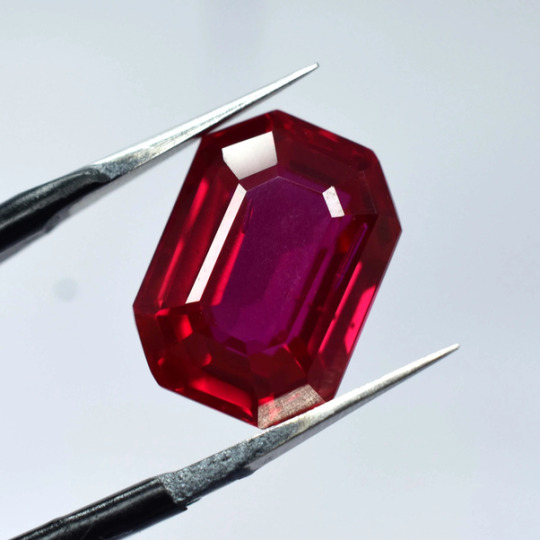
Asian Ruby Treasures: Beyond Myanmar, Asia boasts other ruby sources. Thailand, particularly the Chanthaburi province, has a long history of ruby mining. These Thai rubies often have a darker, more brownish-red hue compared to their Burmese counterparts. Sri Lanka, known for its sapphires, also produces some rubies, with a slightly pinkish tinge.
Beyond the Usual Suspects: Rubies can also be found in less common locations like Afghanistan, Pakistan, and even North Carolina in the United States. These regions typically produce smaller quantities of rubies, and the quality can vary.
Unearthing the Perfect Ruby: The origin of a ruby can influence its value and characteristics. Burmese rubies, with their legendary quality and limited availability, often command a premium price. African rubies offer a compelling alternative with their vibrant color and larger sizes.
3 notes
·
View notes
Text
Ruby: The July Birthstone

Ruby is the July birthstone. The gemstone's name comes from the Latin word "ruber," which means red. Quality rubies are rarer than diamonds with the finest stones found in Burma (Myanmar). However, they are also mined in Afghanistan, Australia, Cambodia, India, Madagascar, Malawi, Mozambique, Pakistan, Sri Lanka, Tanzania, Thailand, Vietnam, and the US.
Ruby Stone Healing Properties
Ruby gemstones are renowned for their fiery red hues and powerful energy that ignites passion, vitality, and courage within the wearer. As a stone of vitality and strength, rubies stimulate the root chakra, promoting a sense of vitality and grounding while energizing the body and mind. In addition to their physical benefits, rubies are believed to bolster emotional resilience, courage, and determination. They inspire confidence, enthusiasm, and a zest for life, empowering individuals to pursue their passions and overcome obstacles with grace and resilience.
Continue reading here.
4 notes
·
View notes
Text
The Burmese Harp
Kon Ichikawa's The Burmese Harp was a neat film with themes involving the cruelty of war and brotherhood among soldiers. It starts off by showing a group of Japanese soldiers, who like to sing and play music, that are partaking in the Burma campaign. Eventually they are caught by British and Indian soldiers, where they soon find out that the war has already ended. After their capture, one of the soldiers, Mizushima, is sent to talk down another group of Japanese soldiers who are holding down a mountain. He fails, the mountain gets bombarded and he is the only survivor. A monk then takes Mizushima and helps him recover. Mizushima later steals his robes and tries to become a monk. During this time, his fellow soldiers are worried for him. Crossing a bridge they see a monk resembling Mizushima, but when they say his name he does not respond, leading them to believe it must have been someone else. As Mizushima walks towards Mudon to where his company was sent, he finds the corpses of many Japanese soldiers. Here is when Mizushima decides that he must stay in Burma, although we as the audience are not directly told this until the very end of the film when the troops are reading Mizushima's letter. Mizushima, clearly horrified at the scene of the many dead soldiers, turns back and this is where he encounters his friends while crossing a bridge. This was a very clever scene that was shown twice, first from the perspective of the troops, and then from Mizushima's perspective. Seeing it from his point of view makes you wonder why he is ignoring his comrades, but when we see captain Inouye look into the box left by Mizushima at the repository of the dead, there is a single ruby inside of it. Mizushima found it earlier and after being told that it represented the spirit of the dead Japanese soldiers, he put it in the box, signaling the start of his mission. It was very moving seeing the troops try to find Mizushima through singing and a parrot, especially when they finally find him and share a moment singing while he plays the harp.
On another note, this film definitely dances on a line when showcasing the presence of Japanese troops in Burma. There is an argument to be made for the film making light of the Japanese invasion, especially when the group of Japanese soldiers seem sweet and pleasant through their song and banter. I don't think the intention was to whitewash, but more so to demonstrate that soldiers in the frontlines were just regular people, drafted into war to further the vision of their government. This doesn't necessarily describe the entirety of the Japanese military, and Ichikawa shows this in the way he presents the intensity of the group of soldiers holding down the mountain. With that being said, The Burmese Harp was a great film and I can see why it was nominated in the Academy Awards of 1956.

2 notes
·
View notes
Text

~ "Sapphires are available in a stunning array of colors and varieties. They can be found in just about every color of the spectrum, including blue, yellow, purple, orange, and green. Some sapphires even exhibit two or more colors, and these are known as 'parti sapphires'. However, it’s important to note that red corundum stones are called rubies rather than sapphires. Here are some of the different colors in which sapphires are available: • Blue Sapphire: Blue sapphires are found in various locations around the world, including Madagascar, Tanzania, Sri Lanka, Myanmar, and Australia. • Pink Sapphire: Pink sapphires were first discovered in Sri Lanka (then known as Ceylon) during the late 1500s. They are also found in other countries such as Australia, Thailand, and Burma. • Yellow Sapphire: Yellow sapphires are primarily sourced from Sri Lanka (Ceylon), which is known for producing fine-quality yellow sapphires. Other countries such as Australia, Thailand, and Burma also produce yellow sapphires. • Orange Sapphire: Most orange sapphires today are sourced from Australia and Madagascar, with others coming from Sri Lanka and Tanzania. • Teal Sapphire: Teal sapphires are found in Australia, Cambodia, Madagascar, Nigeria, and Thailand. • Green Sapphire: Green sapphires are found in various locations, including Madagascar, Tanzania, Sri Lanka, Myanmar, and Australia. • Purple Sapphire: Purple sapphires can be found in different shades ranging from light lavender to deep violet. They are sourced from various locations, including Madagascar, Tanzania, Sri Lanka, Myanmar, and Australia. • White Sapphire: White sapphires are not as common as other colors, but they are known for their brilliance and sparkle. They can be found in various locations, including Madagascar, Tanzania, Sri Lanka, Myanmar, and Australia. • Salmon Sapphire: Salmon sapphires are a unique color that is a delicate blend of pink and orange. They are found in various locations, including Australia, Madagascar, Sri Lanka, and Tanzania. • Violet Sapphire: Violet sapphires are a rich and intense shade of purple with a touch of blue. They are sourced from various locations, including Madagascar, Tanzania, Sri Lanka, Myanmar, and Australia. • Colour-Change Sapphire: Colour-change sapphires exhibit a fascinating phenomenon where their color changes depending on the lighting conditions. They can shift from one color to another, such as blue to purple or green to gray. These sapphires are found in various locations, including Madagascar, Tanzania, Sri Lanka, Myanmar, and Australia. • Bi-Colored Sapphire: Bi-colored sapphires showcase two distinct colors, creating a striking and unique appearance. They are found in various locations, including Madagascar, Tanzania, Sri Lanka, Myanmar, and Australia. • Black Sapphire: Black sapphires, although not truly black, have a very dark and opaque appearance, often resembling black onyx. They are found in various locations, including Madagascar, Tanzania, Sri Lanka, Myanmar, and Australia. Please note that the availability of specific colors may vary depending on factors such as the location of the sapphire mines and the rarity of certain hues." ~
5 notes
·
View notes